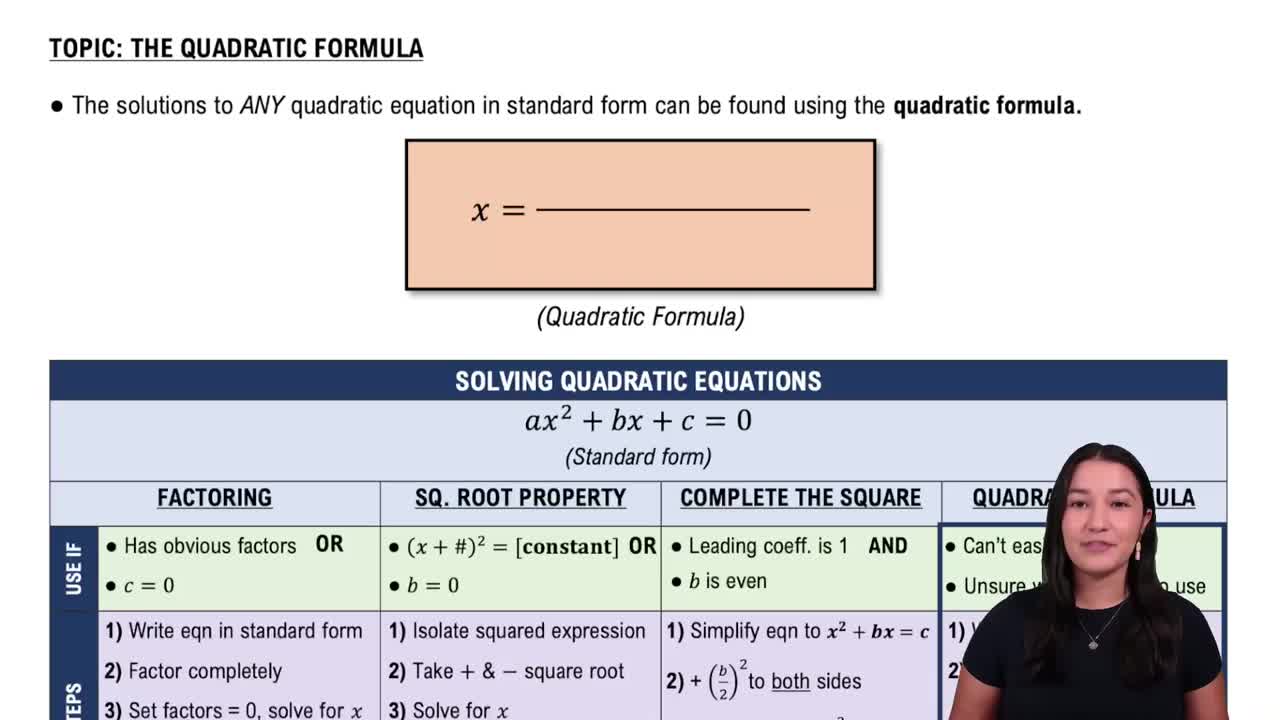Table of contents
- 0. Review of Algebra4h 16m
- 1. Equations & Inequalities3h 18m
- 2. Graphs of Equations43m
- 3. Functions2h 17m
- 4. Polynomial Functions1h 44m
- 5. Rational Functions1h 23m
- 6. Exponential & Logarithmic Functions2h 28m
- 7. Systems of Equations & Matrices4h 6m
- 8. Conic Sections2h 23m
- 9. Sequences, Series, & Induction1h 19m
- 10. Combinatorics & Probability1h 45m
3. Functions
Intro to Functions & Their Graphs
Problem 1d
Textbook Question
To answer each question, refer to the following basic graphs. Which one is the graph of ƒ(x)=x^2? What is its domain?
 Verified step by step guidance
Verified step by step guidance1
Step 1: The graph of the function ƒ(x)=x^2 is a parabola that opens upwards. It starts from the origin (0,0) and spreads out on both sides along the x-axis. The lowest point of the graph is at the origin.
Step 2: To identify the correct graph, look for a U-shaped curve that starts from the origin and opens upwards. This is the graph of ƒ(x)=x^2.
Step 3: The domain of a function is the set of all possible x-values that can be plugged into the function. For the function ƒ(x)=x^2, you can plug in any real number for x and get a real number for ƒ(x).
Step 4: Therefore, the domain of the function ƒ(x)=x^2 is all real numbers, which can be written in interval notation as (-∞, ∞).
Step 5: In conclusion, the graph of ƒ(x)=x^2 is a parabola that opens upwards and its domain is all real numbers.
Recommended similar problem, with video answer:
 Verified Solution
Verified SolutionThis video solution was recommended by our tutors as helpful for the problem above
Video duration:
2mPlay a video:
Was this helpful?
Key Concepts
Here are the essential concepts you must grasp in order to answer the question correctly.
Quadratic Functions
A quadratic function is a polynomial function of degree two, typically expressed in the form ƒ(x) = ax² + bx + c, where a, b, and c are constants. The graph of a quadratic function is a parabola, which opens upwards if a is positive and downwards if a is negative. For the function ƒ(x) = x², the graph is a parabola that opens upwards with its vertex at the origin (0,0).
Recommended video:

Solving Quadratic Equations Using The Quadratic Formula
Graphing Parabolas
When graphing a quadratic function like ƒ(x) = x², key features include the vertex, axis of symmetry, and direction of opening. The vertex is the lowest point for upward-opening parabolas, and the axis of symmetry is the vertical line that passes through the vertex. The shape of the graph is determined by the coefficient of x², which influences the width and steepness of the parabola.
Recommended video:

Horizontal Parabolas
Domain of a Function
The domain of a function refers to the set of all possible input values (x-values) for which the function is defined. For the quadratic function ƒ(x) = x², the domain is all real numbers, denoted as (-∞, ∞), because you can substitute any real number for x and obtain a valid output. Understanding the domain is crucial for analyzing the behavior of the function and its graph.
Recommended video:

Domain Restrictions of Composed Functions

 5:2m
5:2mWatch next
Master Relations and Functions with a bite sized video explanation from Nick Kaneko
Start learningRelated Videos
Related Practice






